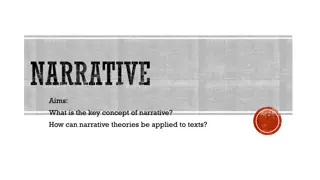Understanding Audience Spectatorship in Films
Explore the concepts of passive and active spectatorship in films, delving into how audiences can be categorized into primary and secondary, and the differences between passive acceptance and active engagement with cinema. Discover how spectators respond differently to films, the influence of key elements on interpretation, and ways to analyze and derive personal meaning from cinematic experiences.
Uploaded on Aug 22, 2024 | 0 Views
Download Presentation

Please find below an Image/Link to download the presentation.
The content on the website is provided AS IS for your information and personal use only. It may not be sold, licensed, or shared on other websites without obtaining consent from the author. Download presentation by click this link. If you encounter any issues during the download, it is possible that the publisher has removed the file from their server.
E N D
Presentation Transcript
Captain Fantastic: Spectatorship
Lesson Aims Learners should understand how audiences can be separated into primary and secondary and the difference between a passive and active audience Key words: primary audience, secondary audience, passives audience, active audience, reception analysis.
Starter Primary Audience: Also known as the target audience; who the film is aimed at. Secondary Audience: Describes viewers who are considered to be outside the primary target audience and are viewers who can affect statistics if not accounted for. TASK 1 Who would be the primary and secondary audience for these films? Consider GENDER, AGE, CLASS, INTERESTS.
Spectatorship & the exam board The concept of passive and active spectatorship How spectators respond differently to the same film Why spectators respond differently to the same film How spectators interact with narrative How spectators respond to the key elements of film form
Spectatorship When we watch a film,there are different ways we can consume and interpret it.An audience member can watch from either an active or passive standpoint. This position is fluid, however, and is often heavily influenced by the way key elements of film form are constructed. Passive Spectatorship A passive spectator is someone who, when watching a film, reacts in the same way that a mass audience would. They accept the director's intended meaning and don t question the messages presented to them. They enjoy the immersive experience and don t seek to engage beyond a superficial level. Active Spectatorship On the other hand, some films (often independent films targeting more niche and highbrow audiences) encourage spectators to become more active producers of meaning by having to think about how to feel and respond to the film. When an active spectator watches a film, they watch it as an individual, and can take their own meaning from it. Active spectators generally analyse films and their meanings.
Passive V Active Consider scenes in which you had a passive or an active response? Write down scenes which meet the following criteria to determine at what points you were passive or active PASSIVE ACTIVE Which scenes made you question your beliefs? Which scenes did you feel you reacted in the same way that a mass audience would? Which scenes made you think about how to feel and respond Which scenes did you accept as the director's intended? Which scenes did you have a more more individual or personal response to? Which scenes were you consciously analysing and searching for meaning? Which scenes didn t you question? Which scenes did you enjoy the immersive experience and didn t engage with beyond a superficial level.
Passive V Active Consider scenes in which you had a passive or an active response? PASSIVE ACTIVE
Spectatorship is the study of how individuals view and respond to films, and includes an examination of how the film positions members of the audience what point of view is the spectator encouraged to assume?
Define Active Audience Define Passive Audience
Reception Theory The filmmaker encodes a film with messages. The audience chooses the extent to which they accept these messages and whether they interpret the film as the director intended. Ross states: at its heart this is a film about family and the perils of parenthood. Captain Fantastic questions what it means to be a father and just what values are important in a family it looks at the cost of idealism and questions to how far a person must go to live an authentic life. Ben isn t quirky; he s fighting for what he believes is right for himself, his kids and the world at large. https://www.theguardian.com/film/2016/jan/31/captain-fantastic-sundance-2016- first-look-review-viggo-mortensen
Audience readings Reception Analysis Reception analysis is concerned with Preferred reading The viewer shares the film s meaning, system of values, attitudes, beliefs and assumptions and fully accepts them, aligning themselves with the filmmakers ideas. how audiences might receive texts taking into account their culture and beliefs how an audience s social and Negotiated reading The viewer partly shares the film s meaning, values and beliefs, but modifies or questions it in a way which reflects their own position and interests. daily routines can influence readings and engagement with different media texts. There are 3 ways in which theorist Oppositional reading The viewer does not share the film s code and rejects the preferred reading, bringing to bear an alternative frame of interpretation in line with their own ideas. (Stuart Hall) suggested a film might be read by the audience:
Reception Definition Film The viewer shares the film s meaning, system of values, attitudes, beliefs and Preferred reading assumptions and fully accepts them, aligning themselves with the filmmakers ideas. The viewer partly shares the film s meaning, values and beliefs, but Negotiated reading modifies or questions it in a way which reflects their own position and interests. The viewer does not share the film s code and rejects the preferred reading, bringing to bear an alternative frame of Oppositional reading interpretation in line with their own ideas.
Reception Definition Film The viewer shares the film s meaning, Question parenting methods To reflect on family life To consider the perils of capitalism, but also the benefits of a free market system of values, attitudes, beliefs and Preferred reading assumptions and fully accepts them, aligning themselves with the filmmakers ideas. To reject entirely what the Cash family believed in The viewer partly shares the film s meaning, values and beliefs, but Negotiated reading To reject entirely what Jack and Abigail were trying to do modifies or questions it in a way which reflects their own position and interests. Leslie and Ben were trying to harm and deprive their children The viewer does not share the film s code and rejects the preferred reading, Jack and Abigail were trying to harm and deprive their grandchildren Oppositional reading bringing to bear an alternative frame of interpretation in line with their own ideas.
Applying to Captain Fantastic Activity applying this to key scenes: 1. Opening Scene 9. Father s Funeral Scene 2. Camp Fire 10. Vespyr falling from roof 3. Ben s Grief in a dream 11. Ben leaving 4. Rock Climbing 12. Mission rescue mummy 5. Noam Chomsky Day 13. Cash Family Funeral 6. Ben s sister s house 14. Bo Leaving 7. Bo and Claire 15. New home 8. Bo and Claire
Exam Questions AS FILM STUDIES Identify how your response as a spectator has been influenced by a particular use of mise-en-sc ne within your chosen film. [10] A LEVEL FILM STUDIES How far do your chosen films demonstrate a constant shift between passive and active spectatorship? Refer in detail to at least one sequence from each film. [40] How far do your chosen films demonstrate the importance of visual and soundtrack cues in influencing spectator response? Refer in detail to at least one sequence from each film. [40]























